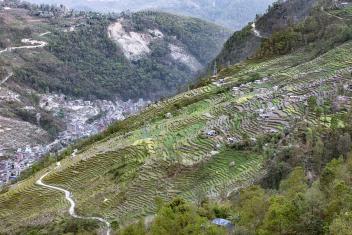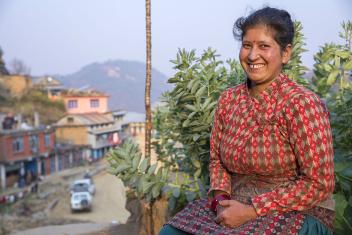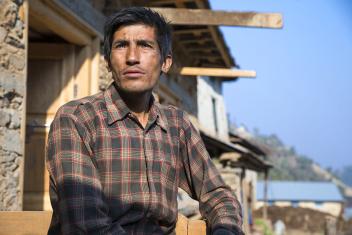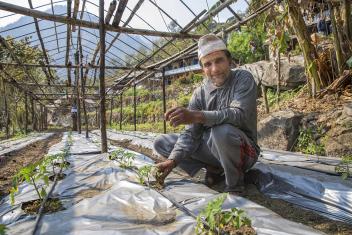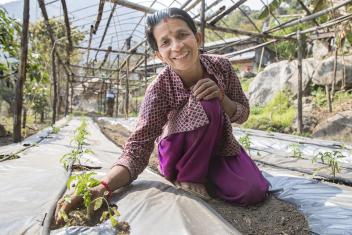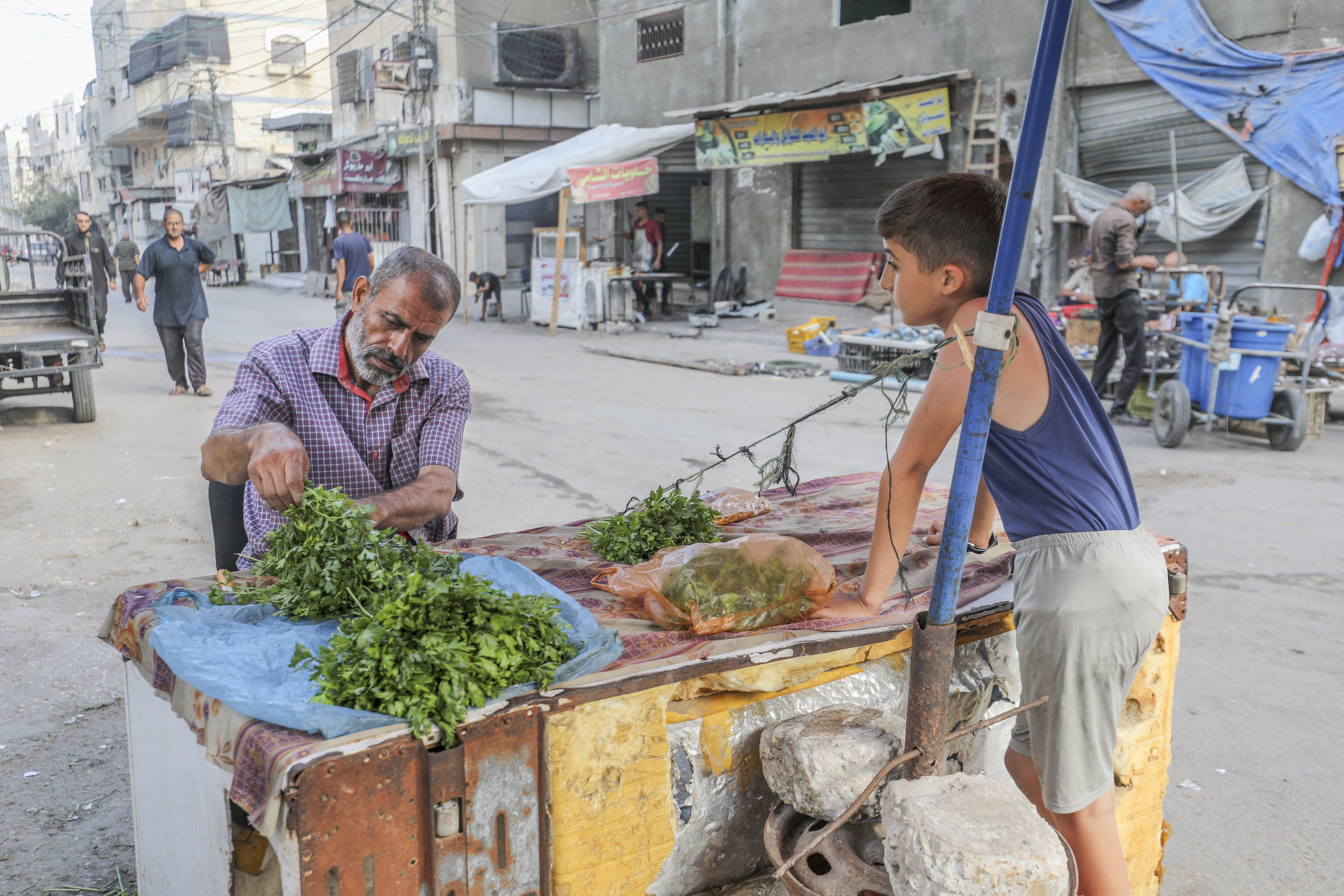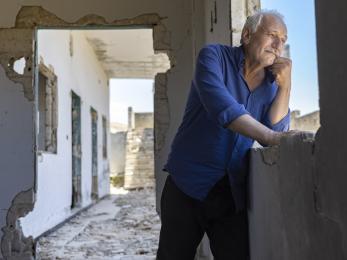The long road to recovery: Three years after quake, Nepalis push ahead
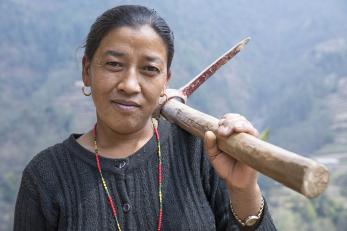
Climbing the quiet, winding dirt roads of the remote mountainside communities outside Kathmandu, Nepal, it’s difficult to imagine the chaos once felt here. Today, in these small villages, farmers quietly tend the vast, green terraces that wrap the hillsides. Children in blue uniforms and backpacks giggle as they walk home from school. Billowy clouds quell the heat as families gather for tea and birds sing a melody in the background. Every now and then, a rooster crows.
Life seems peaceful here, uncomplicated. But with that simplicity comes an innate vulnerability — in a country that was already one of the poorest in the world, recovering from the severe earthquake that struck three years ago has been a difficult process.
The earthquake, a 7.8 magnitude quake, destroyed over 800,000 homes and affected around 8 million people. Nearly 9,000 were killed and 23,000 injured. In a matter of minutes, entire livelihoods and communities were wiped out and 2.8 million people were left in need.
Even now as laughter comes easy and people move calmly through their days, communities still bear the quiet scars of that disaster: temporary shelters, half-constructed buildings, small piles of rubble and a sincere uncertainty as to when things will be back to where they were before.
Mercy Corps responded in the days after the earthquake, helping 135,000 people with emergency aid, and has since been working to help the hardest-hit communities recover and build back stronger than they were before. Three years after the initial devastation, learn what recovery has been like for some of the people we’ve been working with:
Sunmaya
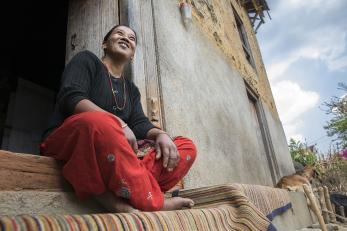
From the doorstep of her home, a modest structure at the top of a narrow, crooked staircase carved into the steep hillside, Sunmaya reflects on the past three years. Her house still shows signs of the earthquake — deep cracks, crooked flooring, a crumbling facade — and she doesn’t know when they’ll come up with the money to repair it.
The damage worries her, but in the wake of the disaster it wasn’t her own home she was concerned about — it was the devastation to her elderly mother-in-law’s house, a short distance below. “It had huge cracks,” Sunmaya says. So she took action.
Sunmaya trained with Mercy Corps for 50 days to learn how to build homes using earthquake-resistant materials and design. “Before the earthquake, I didn’t really think much about building a house,” she says. “But after the earthquake, there were a lot of people rebuilding houses, so I did think that I wanted to build a house. I wanted to go everywhere and build everybody’s houses.”
Learn more about the rebuilding effort ▸
After the training, she constructed a new house for her mother-in-law and was hired to help build three others in her community. Eventually, she wants to rebuild her family’s home, too. “I can build my own house,” she says, acknowledging what she can accomplish with her new set of skills. “I don’t have to hire somebody else. Now I can do my own work.”
Sushma
With a wide, shy smile, Sushma points to the expanse of farmland she now owns and cultivates in her village: great stretches of terraced plots dotted with neat rows of wheat, barley, mushrooms, carrots and many other vegetables.
"At the beginning, the vegetables we grew were just enough for the family," she explains. "Now, I take vegetables to the market to sell every week. We are using the income ... to cover all our household expenses."
When the earthquake toppled her community three years ago, Sushma was faced with the agonizing question of how to rebuild her family’s life from rubble. “We didn’t have a house anymore. … We did not have money at that time to rebuild,” she says. “There were a lot of unknowns: what to do, where to live. We didn’t even have food to eat.”
With a new baby to care for, she and her husband had no choice but to push forward. They began clearing the wreckage, salvaging what they could, and working in neighboring fields to earn a small amount of money. Essential supplies and emergency cash from Mercy Corps helped them begin the slow process of recovery.
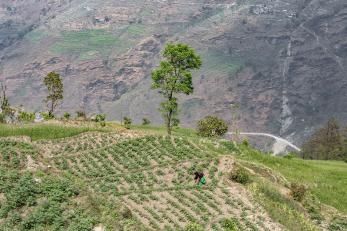
“We used that money to buy seeds and planted our [own] fields,” Sushma explains. The couple took a loan to begin rebuilding their home, and Sushma participated in Mercy Corps’ vegetable farming training to learn how to grow stronger, more diverse crops and secure a more reliable long-term income. Slowly, they put their life back together.
Today, with a roof over their heads and money coming in, she is able to think about the future for the first time in a long time: she wants to expand her farming income to send her children to school. “I didn’t start out with that kind of courage,” she says. “Now, I have been trained. After the training, I realized that I should do something myself to earn money. I realized that if we work hard, we can make things happen.”
Saraswoti
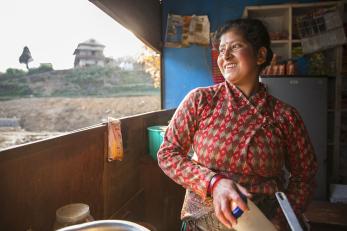
Behind a wide counter piled with dishes and large plastic bins of wrapped candy, Saraswoti gently stirs a pot of noodles, the boiling water releasing tufts of steam into the air. Three skinny men drink tea at a wooden table along the opposite wall while other customers linger at the store’s entrance, considering their purchases.
Three years ago the earthquake brought business at Saraswoti’s snack shop, then at a smaller location, to a halt. “There was a lot of glass and things that got broken. Food got destroyed,” she says. “The business was our only source of income, so we were sure we needed to recover.”
Her community, like many others badly affected by the quake, lacked access to financial services like loans, savings accounts and financial education, so Mercy Corps provided financial literacy training and helped local institutions supply the financial resources people would need to move forward.
“When I took the financial literacy class, I thought about going more professional with my shop,” Saraswoti says. “So we rented the new space and wanted to grow it.” She was able to get a loan to expand — and start two other businesses, growing potatoes and raising chickens.
Today, even while her home still requires repairs, she’s using her new financial know-how to build stability for the future: she invests, sends her children to private school, has an emergency fund and savings for each of her kids.
I have always been enterprising, she says with a laugh. “Wherever there is work to be done. As long as I am alive, I want to work.”
Krishna
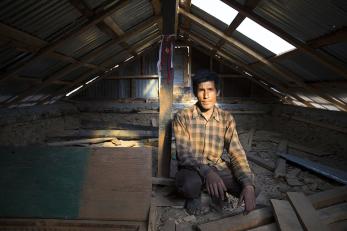
After three years living in a temporary shelter, battling the heat and rain from inside a tent, Krishna is relieved to soon be moving his wife and children into their new, earthquake-resistant house. He has only to clear the last of the construction materials and complete the exterior finishes before they can call it home.
It has been a long journey to get here. The damage done by the earthquake was overwhelming for Krishna: his house had collapsed and he had nowhere safe to take his children. “I could not even sleep because I don’t have money,” he remembers, “and I didn’t know where to start. There was no way for me to start rebuilding.”
More survivor stories from the days after the quake ▸
Mercy Corps’ mason training was welcome support. Because Krishna also has a disability that makes it difficult for him to do intense manual labor, his lot was used for the training’s demonstration house. Over the course of the training, he and the group learned how to build an earthquake-resistant house by actually building one — by building Krishna’s.
The other participants, now skilled masons, have since moved on to build other homes in the community, earning income they can use to support their own recovery. And with the hurdle of safe shelter behind him, Krishna can now focus on other things, including his farming and sending his children to school.
“At that time [of the earthquake], the house was the ground and we didn’t know where to take the kids,” he says. “There was a lot of difficulty we had to go through. Now the house is here and we can move in any time, so we feel secure.”
Shyam and Sabitri
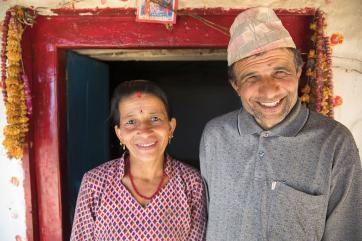
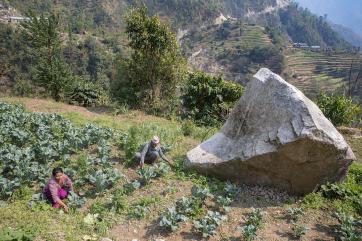
“The day of the earthquake was a day I could never have imagined,” says Shyam (pictured at right, above). “Huge rocks started rolling down the hill and I felt that I might not live.” The earthquake had triggered a landslide that sent massive boulders barreling through their hillside village, razing everything in their path.
Shyam and Sabitri’s home, near the top of the hill, was spared, but the fields and greenhouses they relied on for food and income were destroyed. “We couldn’t stay here,” Shyam explains. “The vegetable farming was all gone. We had to pack up and leave this place.”
Terrified that more rocks would fall, the couple stayed in a temporary shelter with several other families for nearly a year, unable to farm their land and unsure of how to move forward. “We couldn’t imagine a future at all back then,” Shyam says.
They had given up on ever returning home until Mercy Corps secured the hillside with a gabion wall to protect it from future landslides, allowing them to move back into their house and begin recovering their livelihood.
“Mercy Corps came and gave us assurance,” Shyam says, “and slowly, after we felt more and more secure, we started vegetable farming again.”
The couple also received supplies to build new greenhouses and participated in Mercy Corps’ vegetable farming training to learn how to make their land more productive. Today they live peacefully in their home, raising livestock and growing fields full of cauliflower and tomatoes to support themselves.
“I used to think that our home base was destroyed forever," Sabitri says. "Now, I feel that everything is almost back to the way it was before.”
